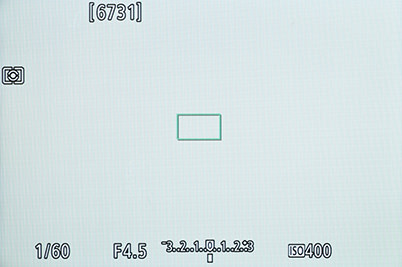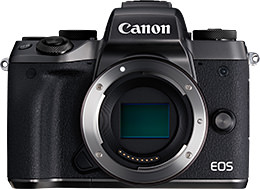The EOS M5 has finally made its appearance. In the second part of the series, I will introduce the enhanced AF function of the EOS M5, which is equipped with a multitude of features befitting Canon’s flagship mirrorless model. (Reported by: Kazuo Nakahara)

* This review was done with a prototype, which may differ in external appearance from the actual product.
TOPIC 1: Fast continuous shooting speed during AF tracking
Many features have been updated on the new EOS M5. In particular, remarkable enhancements have been made to the continuous shooting performance as well as AF-related features. Compared to the EOS M3, the continuous shooting speed has increased by more than twofold to 9 fps, while the speed of 7 fps during AF tracking is almost three times faster.
Not only so, focusing accuracy is high despite the faster continuous shooting speed during AF tracking. AF in the direction of depth, such as when capturing a subject that is approaching the camera, has been enhanced based on the moving subject tracking AF of EOS DSLR cameras. I tried many times to capture continuous shots while tracking a subject that was moving toward the camera, including trains and people, and I was able to achieve focus with high precision every time.
Disruption in the form of blackout time is a characteristic of mirrorless cameras, but this has also been significantly reduced on the EOS M5, thus allowing for a smoother shooting experience. This is made possible thanks to the coordination between the Dual Pixel CMOS AF, in which all pixels function as phase detection sensors, and the DIGIC 7 image processor, which enables high-speed processing. The smoothness of the image during continuous shooting is very much comparable to the quality of the image you would have obtained on an optical viewfinder. This, combined with the ability to view images you capture in real time on a mirrorless camera, has made the EOS M5 a practical choice as a main camera for photographing moving subjects.
Click here for more details about the Dual Pixel CMOS AF
Click here for more details about the DIGIC image processor

EOS M5/ EF-M55-200mm f/4.5-6.3 IS STM/ FL: 200mm (equivalent to 320mm in 35mm format)/ Shutter-priority AE (f/6.3, 1/1,250 sec., EV+0.3)/ ISO 400/ WB: Auto
In this example, I captured the moment when a large soap bubble burst. I tracked the soap bubble with Servo AF and took the shot at a fast shutter speed.
High-speed continuous shooting at 7 fps (AF tracking)
1

2

3

4

5

6

7

EOS M5/ EF-M18-150mm f/3.5-6.3 IS STM/ FL: 150.0mm (equivalent to 240mm in 35mm format)/ Shutter-priority AE (f/7.1, 1/1600sec.)/ WB: Daylight
The above set of images were shot within 1 second. In the High speed continuous shooting mode, you can capture up to 31 shots with AF tracking, and up to 26 with AF lock.
TOPIC 2: “Small” AF frame now available
When in 1-point AF mode, a new “Small” AF frame size is available in addition to the “Normal” AF frame size when 1-point AF is selected. This improves the camera’s capability in photographing subjects that require high focusing accuracy, such as flowers and other small objects. Also, by selecting Smooth Zone AF, which allows the AF frame to move smoothly, subjects with unpredictable movements, such as animals and sports players, can also be captured more easily.

“Normal” AF frame size when 1-point AF is selected

“Small” AF frame size when 1-point AF is selected

EOS M5/ EF-M55-200mm f/4.5-6.3 IS STM/ FL: 200mm (equivalent to 320mm in 35mm format)/ Shutter-priority AE (f/6.3, 1/1,250 sec., EV+0.3)/ ISO 400/ WB: Auto
I set focus in advance on a flower that butterflies would likely be attracted to. With the focusing area set to “Smooth Zone AF”, I took continuous shots of the subject and was able to capture the decisive moment. The EOS M5 also comes in handy when you want to photograph subjects with unpredictable movements.
TOPIC 3: AF frame position adjustable using Touch & Drag AF
Yet another new feature is Touch & Drag AF, which allows you to move the AF frame intuitively. It is similar to the Multi-controller, a joystick control that is found on higher-end EOS cameras. With the revolutionary Touch & Drag AF feature, moving the AF frame is no longer a hassle, as you can do so intuitively simply by sliding your finger on the rear LCD monitor. For users who are familiar with the Multi-controller, you are recommended to set the “Relative” setting at the same time during use.

(1) Whole panel (2) Right (3) Left (4) Top right (5) Btm. right (6) Top left (7) Btm. left
You can set the area for Touch & Drag AF to one of the seven patterns available. You can drag and move the AF frame freely on the rear LCD monitor not just in the 1-point AF mode, but also when Smooth Zone AF is selected. There are two ways of moving the AF frame: use “Absolute” to manually specify a fixed position on screen, or select “Relative” to move the AF frame according to how much you have dragged.

In the “Touch & drag AF” setting menu, there is an “Active touch area” item that allows you to specify which part on the rear LCD monitor to use for Touch & Drag AF.
Receive the latest updates on photography news, tips and tricks by signing up with us!

EOS M5 (Body)

EF-M18-150mm f/3.5-6.3 IS STM

Born in Hokkaido in 1982, Nakahara turned to photography after working at a chemical manufacturing company. He majored in photography at the Vantan Design Institute and is a lecturer for photography workshops and seminars, in addition to working in commercial photography. He is also a representative of the photography information website studio9.

A monthly magazine that believes that enjoyment of photography will increase the more one learns about camera functions. It delivers news on the latest cameras and features and regularly introduces various photography techniques.
Published by Impress Corporation

































